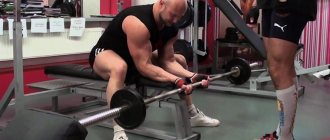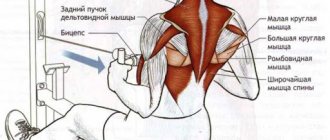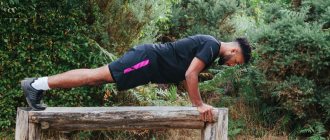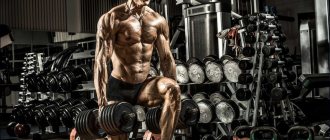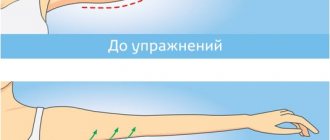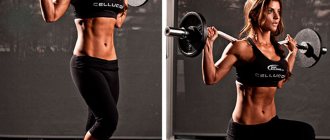What muscles does bent over arm extension use?
As was said at the beginning of the article, bending arm extensions are aimed at developing the triceps.
This is the largest of the shoulder muscles. So if you want huge biceps. Then you need to spend more time developing your triceps. No matter how paradoxical it may sound. The load falls mainly on the upper sections of all three heads of the triceps.
- Lateral. Located on the outside of the shoulder.
- Long. This head is lagging in most athletes. Located on the inside of the shoulder.
- Medial. It is located under the other two. Participates in any triceps exercise.
When performing bent-over extensions, athletes try to place more emphasis on the long head of the triceps. To do this, place your elbows firmly behind your back. Of course, it is worth considering that her dominance over the others will be very small. So you won't notice much of a difference. Therefore, is it worth bothering about this at all?
Technique of one-arm extension while leaning on a bench
There are several techniques that differ from each other in some features. Performing in support on a bench is the most “isolating” option, which allows you to feel every centimeter of arm movement.
Technique:
- Go to the bench, rest your knee and palm on it (arm fully straightened). Bend your other arm at the elbow and hold the dumbbell with a neutral grip. The back is straight, the neck is in a natural position.
- Begin to straighten your arm, moving the dumbbell back and up away from you at a slow pace.
- Without pausing, return to the starting position.
It is important to monitor the following nuances that determine the quality of arm extension:
- The elbow should be pressed as close to the body as possible.
- The upper arm should be parallel to the spine.
- In the starting position, the elbow is bent at a right angle.
- You should not pause at the top; this will not improve efficiency, but will create additional stress on the elbow.
- The exercise is done at a slow pace, excluding inertia and “falling” of the hand in the negative phase.
Advantages and disadvantages of the exercise
Advantages
- This exercise will allow you to work all three heads of the triceps in isolation.
- To perform, only one dumbbell is enough, and not a lot of weight. Therefore, it can be easily done at home.
- Very little risk of injury. Of course, when working with the right weight and good technique.
- Great for girls. Because they just want to shape their arms without increasing the size of their triceps.
- It will help eliminate imbalances in the development of each arm.
- The technique is easy to master. So you don’t have to spend months practicing the movement.
- It will help you finish off your triceps at the end of your workout.
Flaws:
- It is impossible to build muscle mass with bent over arm extensions. Since the weight of dumbbells is not large. Therefore, it is not suitable for beginners. At first, it is best to give preference to PUSH-UPS. If it’s difficult for you to do them, DO PUSH-UPS FROM THE FLOOR.
- Another disadvantage is that there is not always enough space in the training for this exercise.
We must understand that the triceps is a very small muscle. But at the same time, she participates in many pressing, multi-joint exercises. Such as: BENCH PRESS, SITTING DUMBBELL PRESS. And if you also do a large number of exercises purely for the triceps. Then, instead of development, we will get overwork of this muscle. Which can lead to a series of injuries. Therefore, everyone chooses several of the most effective exercises for themselves. But for some reason, many people avoid bending arm extensions. Most likely because it looks too light and ineffective.
Bent over arm extension technique with dumbbells
This variation is an attempt to eliminate the work of the back and shoulder muscles, as well as inertia, when compared with the standing version. Seated arm extensions do not provide any tangible benefits, but may be more effective for those who are unable to focus the work on the triceps.
Technique:
- Sit on the edge of the bench and lean your body forward as much as possible. The back should remain straight. The elbows are bent at a right angle, the arms are pressed to the body.
- Start moving the dumbbells back until your elbow is completely straight.
- Without pausing, return to the starting position.
This movement can be performed with both hands together, alternately, or with one hand.
Recommendations for implementation
- When performing bent-over extensions, do not move your elbows to the side. Try to keep them as close to your body as possible.
- Be sure to pause at the extreme points of the exercise. This will help you concentrate on the movement itself. And it will not give you the opportunity to turn extension into swings.
- When returning the arm to its original position, there is no need to completely bend the arm at the elbow joint. This will take the pressure off your triceps and transfer it to your biceps. It is enough to maintain a 90° angle at the elbow.
- The movement should occur only at the elbow. If you engage the shoulder joint, the exercise will turn from extension to bent-over row.
- Bend your arm slowly, controlling the weight. And we extend it twice as fast, using the force of the triceps.
- The lower the torso tilt, the more you need to raise your elbows up. This technique will be less comfortable. And this may cause pain in the shoulder joint. Therefore, we lean forward almost to parallel with the floor.
- Don't use heavy weights. Because of this, the execution technique will suffer greatly. Therefore, you will not get any results.
Bent over arm extension technique with dumbbells
This version of the execution is often called the “skier”, since the movement of the hands is similar to working with sticks.
Technique:
- Stand straight, feet shoulder-width apart, hold dumbbells in your hands.
- Lean forward as low as possible (ideally, your body should be parallel to the floor) and keep your back straight. Bend your elbows.
- Begin to move both arms back, straightening your elbows.
- Without delay, return to the starting position.
- It is important to ensure that moving the arm back while tilting does not turn into rapid swings of the skier, since the load with this option will be distributed to other muscles. The movement should be done slowly and under control.
- Also try to exclude your shoulders and back from working.
- The degree of load is regulated by the position of the body (the greater the tilt, the stronger the load).
Inclusion in the training program
For men, this exercise is best performed at the end of a workout. In order to finish off the triceps. We perform 3-4 sets of 12-15 repetitions. No warm-up approach is required.
Girls can perform this exercise both at the beginning and at the end. Unless, of course, the goal is to develop large and massive triceps. On average, perform 2-4 sets of 10-12 repetitions.
I think I was able to pull back the curtain a little and help you learn a little more about arm extensions. If you can lead intelligently in your training, then you will clearly have good results. And large developed triceps.
Good luck to everyone in your training!
Exercise technique
- Take a dumbbell in each hand in advance. Sit on a bench, lean your back against a specially designed vertical support, if it is not a horizontal bench. Next, lower your arms with dumbbells as low as possible.
- Raise the dumbbells with light arm movements forward and upward. The elbows should be as motionless as possible.
- When bending your arms with dumbbells, rotate your hands so that at the top point your palms are facing up.
- Raise the dumbbells to their maximum height and tighten your biceps muscles as much as possible.
- Smoothly lower the dumbbells to the starting position.
Number of repetitions: 3-5 sets of 12 repetitions.
Technique for performing bent-over dumbbell rows and common mistakes
If you ask a dozen people at the gym where they feel tension when doing dumbbell rows, they will point to the elbow, biceps, wrists, shoulders, neck, glutes and other parts of the body, but not the lats.
Perhaps it is precisely because of incorrect body position that people subsequently begin to complain of back pain. They mistakenly round the thoracic or lumbar spine, tilt their head too low or, on the contrary, throw it back, place their elbows to the sides, turn their wrists, twist their torso, or jerk the dumbbell.
Here is a video that shows how to properly perform a one-arm dumbbell row while standing in a bent-over position:
The position of the spine affects the movement of the shoulders. Since the latissimus dorsi muscles move the shoulder blades, the pulling motion will only be correct if the upper back is not rounded.
Rounding the back limits the mobility of the shoulder blades and eliminates the ability to engage the latissimus muscles.
Here's a video that shows what a one-arm dumbbell row looks like with a rounded back:
Many people also pull the dumbbell too high, which seems like a good idea when counteracting gravity. But in this case, look at the position of the body: the latissimus muscle is below the shoulder, and the upper part of the trapezius muscle and the levator scapula muscle are above it.
This means that the one-arm dumbbell row will engage the upper trapezius and levator scapulae muscles rather than the latissimus and rhomboids.
Here's what it looks like in practice:
The shoulder blades should be tense and pressed against the back, and the dumbbell should be raised to the level of the upper thigh.
Many people, when performing a dumbbell row with one arm while standing on an incline, also turn their torso to the side and extend their leg at the knee. The exercise begins to somewhat resemble a leg press with a weight in one hand.
The body should be absolutely motionless, and movement should come only from the arm and shoulder.
Here is a video that shows what a dumbbell row looks like while leaning on a bench with torso rotation:
The latissimus muscles act as spinal extensor muscles and are also responsible for fixing the shoulder blades, so a straight back position will allow them to be used more actively.
Many people, instead of tensing their core muscles, tense their abdominal muscles, which causes them to involuntarily pull their pelvis back and, as a result, arch their spine. You shouldn't do this.
And finally, the last mistake concerns incomplete engagement of the shoulder blades, which leads to a decrease in the load on the rhomboid muscles and trapezius.
Here's what it looks like in practice:
The back position here is correct, but the shoulder blades are not tense enough to do their job. This is similar to a dumbbell biceps curl with the arms not fully extended. Of course, the muscles still work, but this is far from ideal.
The cause may be immobility of the front of the shoulder, particularly the clavicular head of the pectoralis major and pectoralis minor muscles, as well as weakness of the rhomboid muscles. Often a little stretching can improve the position and increase your range of motion.
Here is an example of how you can perform myofascial release yourself:
What does the exercise do?
Extension of the arm with dumbbells while standing in an inclined position can be performed by both men and women, due to the undemanding nature of the element to the strength of the core and shoulders. During the training process, an isolated effect on the triceps occurs, giving the man the opportunity to emphasize the relief and add volume to the arms. Girls can practice bent over arm extensions with a light dumbbell - this will be enough to improve the shape of their arms and get rid of sagging on the back side.
Additionally, bent over dumbbell extensions:
- It will allow you to equalize the volume of the triceps of different arms by doing different numbers of repetitions.
- It will give beginners the opportunity to develop basic triceps strength in order to easily move on to complex training.
Exercise technique
- To perform one-arm dumbbell rows, take the starting position : hold the dumbbell in your right hand with a neutral grip so that your palm faces the side of your thigh. Next, stand to the left of the bench and place your feet together. Make sure your torso is parallel to the floor and your back is slightly bent at the waist. Straighten your right arm completely and lower your shoulder slightly down. This position will be the starting position.
- Take a deep breath and hold your breath. Feel the tension in your back muscles and rear deltoid muscles. At the same moment , pull the dumbbell up and try to lift it as close to the ceiling as possible.
- At the moment when your elbow is at shoulder level, engage your shoulder and pull it up following your elbow. This technique will help increase the contraction of the back muscles, including the latissimus muscles.
- Hold the dumbbell at the highest point for several counts. Then exhale and slowly lower the dumbbell.
- Repeat the one-arm dumbbell row on the other side of the bench to target the opposite side of the latissimus dorsi.
